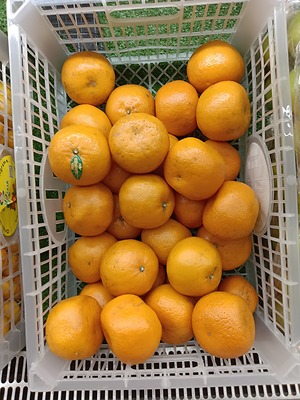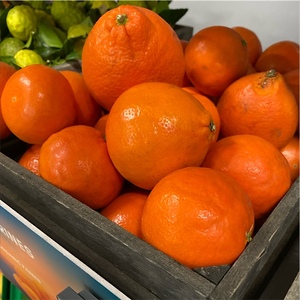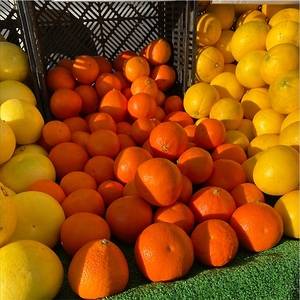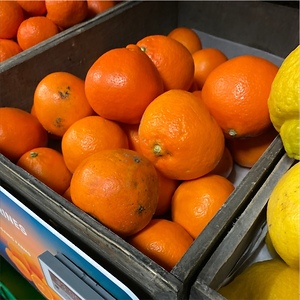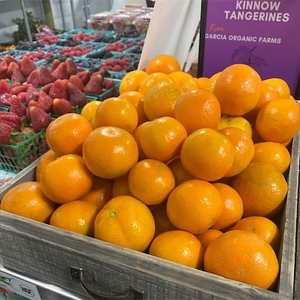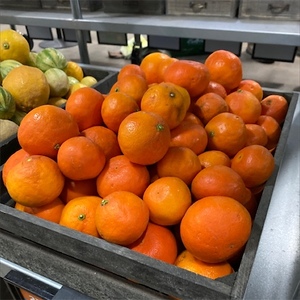

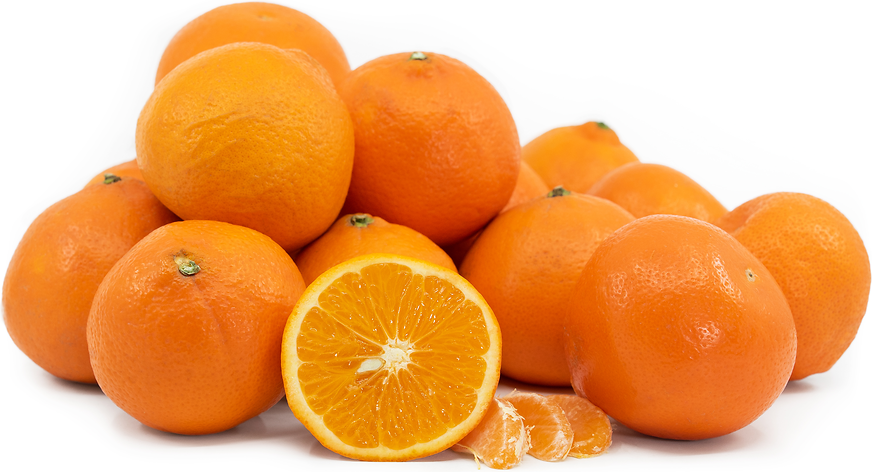
Kinnow Mandarins
Estimated Inventory, lb : 0
Description/Taste
Kinnow mandarins are a medium-sized varietal, averaging 7 to 8 centimeters in diameter, and have a round to oblate shape, showcasing a slightly flattened top and bottom. The mandarin’s rind is thin, smooth, and glossy, lightly pitted with sunken oil glands. The rind is also dark orange, sometimes blushed with hints of red, and is tough but still relatively easy to peel, revealing orange flesh divided into 9 to 10 segments by thin membranes. The flesh is soft, tender, and aqueous, containing anywhere from 15 to 30 seeds in one fruit. Despite their seedy nature, Kinnow mandarins are aromatic and have a bright, pronounced, and richly sweet, tart, and tangy flavor with fruity and floral nuances.
Seasons/Availability
Kinnow mandarins are available in the winter through early spring.
Current Facts
Kinnow mandarins, botanically classified as Citrus reticulata, are a mid to late season variety belonging to the Rutaceae or citrus family. The glossy, smooth mandarins were developed at the University of California Citrus Experiment Station in the early 20th century and were selected as a commercial cultivar for the variety’s productive nature. Kinnow mandarins can produce over 1,000 fruits per tree, and the dense foliage shades the fruits, allowing the cultivar to be grown in warmer, desert climates. The rich, juicy fruits are highly favored for their tender, succulent flesh, and sweet-tart taste, but Kinnow mandarins are often overlooked for widespread commercial cultivation due to their seedy nature, a trait considered unfavorable in the seedless mandarin market. Kinnow mandarins are a niche market citrus in select countries, also known as Kinno, Kinu, and Kinoo mandarins, and are primarily consumed straight, out of hand as a fresh cultivar.
Nutritional Value
Kinnow mandarins are an excellent source of fiber to stimulate the digestive tract and vitamin C to strengthen the immune system while reducing inflammation. The fruits also provide vitamin A to maintain optimal organ functioning, antioxidants to protect against free radical damage to cells, potassium to balance fluid levels within the body, and lower amounts of folate, calcium, phosphorus, iron, and copper.
Applications
Kinnow mandarins have a rich, sweet-tart flavor well suited for fresh preparations. The fruits are traditionally consumed straight, out of hand, and are highly favored for their full-bodied juice and soft consistency. Kinnow mandarins are mostly consumed raw due to their high seed content. The flesh segments can be deseeded and tossed into salads, blended into smoothies, or used as a refreshing topping over parfaits, oatmeal, and grain bowls. In addition to eating the mandarins whole, the juice can be pressed and consumed as a tangy beverage, stirred into cocktails, or used to flavor carbonated beverages. Kinnow mandarin juice can also be used to flavor desserts and baked goods, or they can be simmered into sauces, dressings, glazes, and marinades for a zesty flavor. Kinnow mandarins pair well with fruits such as coconut, bananas, mangos, and berries, herbs including mint, basil, and rosemary, maple syrup, vanilla, caramel, and chocolate. Whole, unwashed Kinnow mandarins will keep for a couple of weeks when stored in a plastic bag in the refrigerator’s crisper drawer.
Ethnic/Cultural Info
Kinnow mandarins are the most commercially cultivated mandarin variety in Pakistan, accounting for more than 85% of the citrus produced within the country. In Pakistan, the mandarins are primarily grown in the Sargodha District of Punjab, a region situated on the border of India and Pakistan. Kinnow mandarins were brought to the region from the United States in 1940 as a potential commercial cultivar, and the variety adapted well to the semi-arid, temperature fluctuating region. After their introduction, Kinnow mandarins were extensively planted across the district, valued for their productive nature, and packing facilities were constructed to grow, package, and export the citrus in one centralized area. In the present day, a sign featuring Kinnow mandarins can be seen along the side of the road when entering the Sargodha District, and the region is nicknamed the “California of Pakistan.” Despite their rich flavor, Kinnow mandarins have been met with pushback from importing countries as consumer demand is growing for seedless cultivars. Several seedless Kinnow mandarins have been developed in the 21st century, including a seedless variety in Pakistan, the PAU Kinnow-1 in India, and the Kinnow LS at the University of California Riverside Research Center.
Geography/History
Kinnow mandarins are native to California and were developed at the Citrus Research Center at the University of California, Riverside. Howard B. Frost created the variety in 1915 from a cross between king, a mandarin-orange hybrid, and willow leaf, another mandarin cultivar. Kinnow mandarins were trialed and studied for over twenty years before being released to commercial markets in 1935. The variety was only grown and sold in California and Arizona for several years, but over time, the mandarin was removed from commercial production in the United States due to changing consumer preferences for seedless mandarins. Kinnow mandarins were later introduced to Pakistan and India as a new commercial cultivar, and the variety flourished in production, leading Pakistan and India to be the primary Kinnow mandarin producers. Today Kinnow mandarins are still widely cultivated in India and Pakistan, specifically the Punjab region, and are sold to domestic and export markets. Kinnow mandarins are exported to Russia, Ukraine, Singapore, Malaysia, the Philippines, areas of the Middle East, the Netherlands, and the United Kingdom. They are also grown in home gardens and on a small scale through specialty farms in California and Arizona of the United States. The Kinnow mandarins featured in the photograph above were sourced from a supermarket in Singapore.



